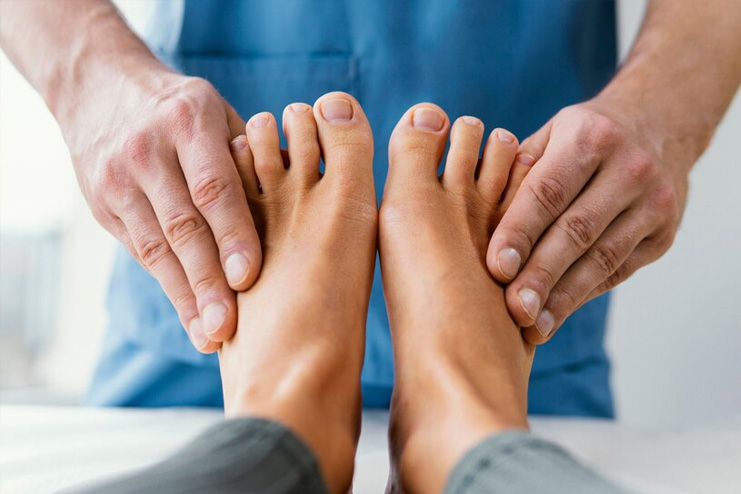Affiliate Disclaimer
Some links in this article are affiliate links. We may earn a small commission if you make a purchase through these links, at no extra cost to you. We only recommend products we find useful to our readersFor someone struggling with diabetes, diet is not the only factor that needs changing. The individual must prioritize an active lifestyle just as much.
Even studies (R) have found walking to be one of the most effective physical activities for diabetes. It is not just easy, but is soothing and relaxing and you don’t require a setting to get started. You can do it on your lawn, garden, or even on the roads.
It helps regulate blood glucose levels and ensure better health in the long run. It is also one of the most effective ways to manage the effects of insulin resistance in the body.
How Does Walking Help With Diabetes?
The correlation of walking with diabetes is not just folklore. It does help with the management of diabetes in the long run.
The connection between walking and diabetes management is well-supported by evidence, not just folklore.
A 30-minute walk can provide several significant health benefits, particularly in managing and controlling diabetes symptoms.
-
Proper Glucose Control

If your blood sugar levels tend to spike, walking is one of the most effective ways to bring them down. Exercise helps your muscles absorb excess glucose from the bloodstream, reducing blood sugar levels.
However, this is a gradual process. The benefits may not be immediate; sometimes, the effects last only a few hours, while in other cases, they may persist for a few days. Consistency is key to long-term glucose control.
-
Improved Heart Health

Diabetes itself is not the main issue; it’s the complications that arise from it that make the situation more challenging.
Studies (R) have shown that diabetes patients have an increased risk of heart disease. Walking helps manage both conditions and supports overall health.
-
Weight Management

Obesity is one of the risk factors for diabetes. If you don’t want its implications to affect your condition further, you must walk for 20-30 minutes a day.
Walking helps burn calories in the body and improves weight loss results.
Emphasis on Foot Care While Walking

When it comes to walking for diabetes, foot care is something you just can’t take for granted. Maintaining foot health is extremely crucial for diabetics. Consult a podiatrist.
Any kind of negative impacts on your foot including abrasions, blisters, etc. are often hard to detect because the patients experience numbness of feet.
They can offer advice on alternatives or precautions to help maintain your foot health.
Choosing The Right Walking Shoes

Shoes play a crucial role in walking too. Keep certain factors in mind while choosing walking shoes.
- Fit: When you are buying shoes for walking, they must fit comfortably. You don’t need them to be too loose or too tight. Make sure that you can move your toes freely inside the shoe. This is necessary. Avoid running shoes because they have a more flexible and flatter design, which may not provide the support needed for walking.
- Wear Socks: It is not just the shoes that you need to focus on, the socks matter just as much. Cotton socks are often the best option as they help soak in the moisture and keep your feet dry. Avoid uncomfortable synthetic fabrics because they do no good to your feet and will only cause your feet to sweat more while walking.
Effective Tips for Walking for Diabetes That Works
Even the American Association of Diabetes has clarified that there are no restrictions on exercise types for diabetics, so feel free to choose what works best for you.
1. Get Into a Habit First
Since diabetics often suffer from lethargy because of the lack of energy, they often don’t feel like going out.
This is why forming a habit is important. Making it a routine will keep you consistent, which is essential for long-term benefits.
Experts also suggest diabetics walk for at least 4-5 days a week for better results. You can start slow walking or gradually build up to brisk walking for 30 minutes.
2. Shoes and Socks Matter

Both the shoes and the socks matter when it comes to walking for diabetes. The right pair of comfortable shoes can help elevate the overall experience for you. It prevents the risks of blisters and ensures that you are comfortable while walking.
Apart from that, socks are equally important. They absorb the excess moisture from the feet and protect the feet from the risks of shoe bites and infectious wounds.
3. Analyze Your Blood Sugar Levels

Monitoring your blood sugar levels before and after walking is essential, even if it seems it isn’t needed.
If your blood sugar level is too low, below 140 mg/dL, you need to consume some carbs before heading out. Persistent physical activity with low blood sugar levels can lead to dizziness.
Eat something and wait for 15 minutes for your blood sugar to stabilize before you step outside the door.
But, if your blood sugar levels are above 300 mg/dL, it is best to skip your walk for the day. If you are someone who goes out for walks quite often, you must focus on getting your blood sugar levels checked every once in a while.
4. Ascertain The Timing

For type-1 diabetics, morning walks are recommended because insulin levels are typically at their peak, making it easier to manage blood sugar levels and maintain overall health.
Studies (R) walking about 30 minutes after a meal is highly effective for both type 1 and type 2 diabetics. This timing helps to lower post-meal blood sugar levels, which is crucial for diabetes management.
5. Keep an Eye on The Insulin Dosage

Walking is highly recommended for diabetics because it helps regulate blood sugar and insulin levels. As you make walking a regular habit, it’s important to monitor your insulin dosage closely.
If you notice that your body requires less insulin than before you started walking, it’s crucial to consult your physician. Regular check-ups will help ensure that your insulin dosage is appropriately adjusted to match your increased physical activity. Proper management of insulin dosage can prevent hypoglycemia and help you maintain optimal blood sugar levels.
6. Carry a Snack with You

While walking, it’s not uncommon for blood sugar levels to drop, especially if you’re exerting yourself more than usual. To prevent any risks associated with low blood sugar, always carry a snack with you.
If you plan to increase the intensity of your walking routine, keeping a snack handy becomes even more crucial. This precaution ensures you have something to stabilize your blood sugar levels, preventing fainting or other complications from a sudden drop in glucose.
7. Carry a Water Bottle

Hydration is particularly important for diabetics. Because people with diabetes often experience increased thirst, staying hydrated during a walk is crucial.
For a typical 30-minute walk, drinking plain water should suffice. However, if you plan on engaging in a more intense or prolonged workout, such as a 2-hour walk, it’s advisable to bring along a drink that can help replenish lost electrolytes as well. This ensures that your body remains well-hydrated and balanced, helping you avoid dehydration and its associated risks.
8. Get Yourself a Walking Buddy

Having a walking buddy can significantly enhance your commitment to regular exercise. A buddy provides not only motivation but also a sense of security during your walks, especially if you have a severe case of diabetes.
Walking with a companion ensures that you stick to your routine, and it’s helpful to have someone who can assist you or get help if anything goes wrong. Additionally, if your diabetes is severe, it’s wise to wear a medical emergency bracelet. This can alert others to your condition if you or your buddy need help during your walk.
9. Know the Signs

Before starting your walking routine, it’s essential to familiarize yourself with the signs of hypoglycemia. Recognizing these symptoms early can prevent your condition from worsening and help you take prompt action.
Common signs of hypoglycemia include:
- Weakness
- Drowsiness
- Cold and clammy hands
- Headache
- Paleness
- Trembling
- Increased heart rate
- Hunger
- Confusion
In case you experience any of these symptoms while out on a walk, find a safe place to sit down and collect yourself. If you have a snack with you, eat it to help stabilize your blood sugar levels. Take a few minutes to relax and monitor how you feel before continuing or deciding to head back home.
How to Start a Walking Program for Diabetes

Starting a walking program when managing diabetes involves careful planning and execution to ensure it’s both effective and safe. Here are some key steps to help you create a successful walking program:
- Start with a slow process and avoid trying to go all out just yet. You must build up your stamina. So, start by walking for 10 minutes the first day and then working your way up from there. Avoid walking to a point where you feel sore. This can put a full stop even before you start walking. This is the reason why it is always best that you start small and steady.
- Keep the targets similar for each week. So, if you are walking for 10 minutes the first week, keep it like that for the first week. Then, gradually increase it by another 5 minutes for the next week. For this, you want to gradually amp it up to 45 minutes to an hour, walking a minimum of five days a week for better results.
- Take some breaks in between. If you are walking for 30 minutes today, try and break it up into two segments of 15 minutes each instead of walking consistently. This lets you calm your body down and even promotes better breakdown and utilization of the sugar molecules in the body.
- Wear a tracker. This is not necessarily mandatory but this can help keep track of your steps and your level of fitness. So, in case you have been trying to keep track of things, this is a must-have for you, without any further complaints at all.
- Setting a specific place for walking is amazing. It helps you build a routine but at the same time, it is also quite helpful in enhancing your social skills for the better. Parks and community centers are often quite an amazing option. In case you have a garden out back of your house, that is a good option as well.
How Much Walking is Enough?
Determining how much walking is sufficient for managing diabetes involves balancing activity levels with your health needs and personal goals.
The 30-Minute Walking Plan
The 30-minute walking plan is often considered one of the best options for diabetes control.
This plan typically involves walking briskly for 20 minutes, followed by a slower pace for the remaining 5-10 minutes.
This approach helps keep your body in optimal shape and supports better health management.
It is also believed that walkers who consistently log around 10,000 steps a day are more likely to achieve their goals faster compared to those who do not.
This is one of the primary reasons doctors recommend using a fitness tracker while walking. It provides valuable insights and helps you plan your activities more effectively.
Why Consult a Doctor?

Consulting a doctor before starting a walking program is crucial, even though walking is generally beneficial for diabetes.
Before beginning any new exercise routine, it’s important to have your plan approved by your doctor. They can assess your current activity levels and determine whether the proposed routine is suitable for you.
Your physician can also identify any potential side effects or necessary precautions, ensuring you follow a safe and effective exercise program.
Conclusion
If you’re hesitating to start walking as part of your diabetes management, it’s time you reconsider your decision. Walking offers numerous benefits for overall well-being, including regulating blood sugar and insulin levels, and reducing the risks associated with diabetes. However, it’s important to consult with your doctor before starting a walking program. This step ensures that you tailor your exercise routine to your specific health needs and monitor your progress effectively.
-
May 2020Written by Somapika D
-
Nov 2024Edited by Lakshmi Gayatri
In this Article


















